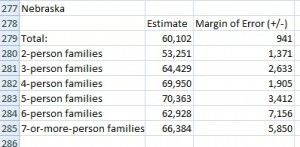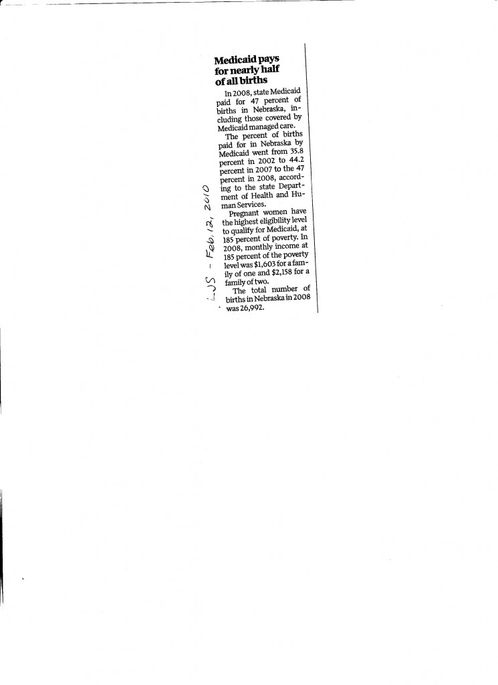Several articles we’ve published recently reported 1 on a meeting of Nebraska Senators representing districts in Lancaster that occurred on November 17 in Lincoln. One of those articles, NE Senators Meeting 11/17 Part 2: Voices Not Often Heard, focused on remarks Linda and I made addressing core questions regarding the true purpose of government and whether or not the $900 million+ – $1.4 billion budget shortfall is being taken seriously enough. Linda focused in particular on the serious problems with Nebraska’s Medicaid system.
Following the meeting, Linda sent a letter to the Senators who attended to reinforce several of the points she’d made, which we are sharing, below. Linda did some additional research following writing her letter, which lays out even more problems coming with Medicaid, which you can read about HERE.
Senators:
I want to thank Senator Coash for publicizing the meeting of Lancaster County Senators last week. I would encourage all of you to consider holding several such meetings throughout the year to hear constituent concerns.
During the meeting, I made several comments about the state Medicaid program. The first concerned the percentage of births paid for by Medicaid funds during 2008. Senator Coash expressed some skepticism about the accuracy of the percentage I quoted. I obtained that figure from a news article that was published in the Lincoln Journal Star on February 12, 2010. I happened to have a copy of the article in my files, so I’ve scanned it and attached it to this email. [Editor’s note: see image, below]
As you can see from the article, Nebraska’s Medicaid program covers pregnant women with incomes up to 185% of the federal poverty level. Although the article contains monthly income figures that were current at that time, the federal poverty guidelines were updated in August of 2010. I have the current yearly income limits at 185%. They are:
$20,035.50 for a family of one
$26,954.50 for a family of two
$33,873.50 for a family of three
$40,792.50 for a family of four
$47,711.50 for a family of five
$54,630.50 for a family of six
$61,549.50 for a family of seven
$68,468.50 for a family of eight or more
I’ve attached a table taken from a report I found at the U.S. Census Bureau website that gives estimates of the median income for Nebraskans by household size. [Editor’s Note: See image, below.] In case any of you are unfamiliar with statistics, a median is a measure of central tendency. The median income earned by a particular population is that amount of income above which half the population falls and below which the other half of the population falls. Median incomes are often used for comparison purposes because, unlike means (i.e., averages), median incomes are less subject to skew (i.e., distortion) by extremes at either end.
If you compare the annual income figures I’ve calculated at 185% of federal poverty limits with the Nebraska median income data, several facts become clear. First, as family size increases, Medicaid eligibility limits approach the median income levels earned by families of that size in Nebraska. The two numbers are very close to equal by the time you reach family sizes of six or more, especially if you consider the margin of error reported in the Census’s median income data.
But, more importantly, births in Nebraska are not distributed evenly among and between different income groups. If the births were distributed evenly across income groups in the population, you would expect roughly 50 percent of the births to occur to families with incomes above the median income and 50 percent of the births below the median income. But the assumption that there should be a completely even distribution ignores the fact that children are more likely to be born to younger families who tend to be less well-established financially. So, there should be some skew in the birth data. There should be relatively more births occurring to those who fall below the median income levels reported in the Census data. However, the 2008 Medicaid data show that almost half of the births in Nebraska occur in that quarter of the population that earns the least money.
I venture to ask, should this be so? Have we created a system which reinforces irresponsible decisions on the part of those who can least afford the consequences of those decisions? Are we perpetuating a culture of dependency from which those families will be hard-pressed to escape? In the process, will the system we’ve created and the entitlement mentality that it has bred in our fellow citizens bankrupt us all? I fear so. That’s why I urged each of the Senators still present at last week’s meeting to consider crafting a safety net for Nebraska that takes care of the truly needy while, at the same time, fostering personal responsibility and allowing a place for private charity in the mix. The state should never be the payer of first resort.
In case you missed it, there is an article in today’s Wall Street Journal that shows I am not alone in questioning whether it is time for the states to chart their own course in caring for the less fortunate among us.
Thank you for your time and consideration.
Linda Rohman
Note: We are including the scanned image of the below, of the Lincoln Journal Star article from 2/12/10 because we have not been able to locate it anywhere on the site despite several variations on search terms.
__________
- The first article we published, “Some NE State Senators Meet This Wednesday & GiN Was There”, focused on the first half of the meeting regarding Nebraska’s child welfare system. The third article questioned whether Senator Amanda McGill was “Deserving of Darts” for being so aghast when Linda questioned whether Nebraska welfare program policies are encouraging irresponsible behavior; “Deserving of Darts? Senator Amanda McGill & Personal Responsibility”. ↩



You must be logged in to post a comment.